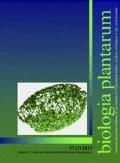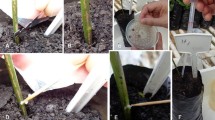Abstract
Pea (Pisum sativum L.) somaclones of cultivars Adept, Komet and Bohatýr were obtained after selection in vitro with Fusarium solani filtrate and fusaric acid (FA). R2 regenerants were analysed by random amplification of polymorphic DNA (RAPD; OPAB4, P-14, UBC-556) and inter-retrotransposon amplification polymorphism (IRAP; Ogre) markers. Marker UBC-556 showed different banding patterns for each cultivar, but without specific bands for selected and control plants. Markers OPAB4, P14 and Ogre were useful for clear discrimination between selected and non-selected variants of all three cultivars. Flow cytometry analysis proved the same genome size of selected and non-selected pea lines. Therefore in vitro selection by pathogen derived agents could be the efficient method for obtaining of pea somaclones with increased resistance to F. solani.
Similar content being viewed by others
Abbreviations
- BAP:
-
benzylaminopurine
- FA:
-
fusaric acid
- IRAP:
-
inter-retrotransposon amplification polymorphism
- ISSR:
-
intersimple sequence repeat
- NAA:
-
naphthaleneacetic acid
- RAPD:
-
random amplification of polymorphic DNA
References
Bacon, C.W., Porter J.K., Norred, W.P., Leslie, F.J.: Production of fusaric acid by Fusarium species. — Appl. environ. Microbiol. 62: 4039–4043, 1996.
Coyne, C.J., McClendon, M.T., Walling, J.G., Timmermann-Vaughan, G.M., Murray, S., Meksem, K., Lightfoot, D.A., Schultz, J.L., Keller, K.E., Martin, R.R., Inglis, D.A., Rajesh, P.N., McPhee, K.E., Weeden, N.F., Grusa, K M.A., Li, C.M., Storlie, E.W.: Construction and characterization of two bacterial artificial chromosome libraries of pea (Pisum sativum L.) for the isolation of economically important genes. — Genome 50: 871–875, 2007.
Doležel, J., Binarová, P., Lucretti, S.: Analysis of nuclear DNA content in plant cells by flow cytometry. — Biol. Plant. 31: 113–120, 1989.
Freytag, A.H., Rao-Arelli, A.P., Anand, S.C., Wrather, J.A., Owens, L.D.: Somaclonal variation in soybean plants regenerated from tissue culture. — Plant Cell Rep. 8: 199–202, 1989.
Galbraith, D.W., Harkins, K.R., Maddox, J.R., Ayres, N.M., Sharma, D.P., Firoozabady, E.: Rapid flow cytometric analysis of the cell-cycle in intact plant-tissues. — Science 220: 1049–1051, 1983.
Gamborg, O.L., Miller, R.A., Ojima, K.: Nutrient requirements of suspension cultures of soybean root cells. — Exp. Cell Res. 50: 151, 1968.
Gesteira, A.S., Otoni, W.C., Barros, E.G., Moreira, M.A.: RAPD-based detection of genomic instability in soybean plants derived from somatic embryogenesis. — Plant Breed. 121: 269–271, 2002.
Greilhuber, J., Doležel, J., Lysák, M., Bennett, M.D.: The origin, evolution and proposed stabilisation of the terms “genome size“ and “C-value“ to describe DNA contents. — Ann. Bot. 95: 255–260, 2005.
Griga, M., Tejklová, E., Novák, F.J., Kubaláková, M.: In vitro clonal propagation of Pisum sativum L. — Plant Cell Tissue Organ Cult. 6: 95–104, 1986.
Hess, M., Barralis, G., Bleiholder, H., Buhr, L., Eggers, T.H., Hack, H., Stauss, R.: Use of the extended BBCH scale — general for the descriptions of the growth stages of mono- and dicotyledonous weed species. — Weed Res 37: 433–441, 1997.
Hirochika, H.: Activation of tobaco retrotransposons during tissue culture. — EMBO J. 12: 2521–2528, 1993.
Horáček, J., Griga, M., Smýkal, P., Hýbl, M.: Effect of environmental and genetic factors on the stability of pea (Pisum sativum L.) isozyme and DNA markers. — Czech J. Genet. Plant Breed. 45: 57–71, 2009.
Kalendar, R., Grob, T., Regina, M., Suoniemi, A., Schulman, A.: IRAP and REMAP: two new retrotransposon-based DNA fingerprinting techniques. — Theor. appl. Genet. 98: 704–711, 1999.
Kuzniak, E.: Effect of fusaric acid on reactive oxygen species and antioxidants in tomato cell cultures. — J. Phytopathol. 149: 575–582, 2001.
Larkin, P.J., Scowcroft, W.R.: Somaclonal variation a novel source of variability from cell cultures for plant improvement. — Theor. appl. Genet. 60: 443–455, 1981.
Lebeda, A., Švábová, L.: In vitro screening methods for assessing of plant disease resistance. — In: Spencer, M.M., Lebeda, A. (ed.): Mass Screening Techniques for Selecting Crops Resistant to Diseases. Pp. 5–45. IAEA, Vienna 2010
Loureiro, J., Suda, J., Doležel, J., Santos, C.: FLOWer: a plant DNA flow cytometry database. — In: Doležel, J., Greilhuber J., Suda J. (ed.): Flow Cytometry with Plant Cells. Pp. 423–438, Willey, Weinheim 2007.
Lysák, M.A., Doležel, J.: Estimation of nuclear DNA content in Sesleria (Poaceae). — Caryologia 51: 123–132, 1998.
Matsumoto, K., Barbosa, M.L., Souza, L.A.C., Teixeira, J.B.: Race 1 fusarium wilt tolerance on banana plants selected by fusaric acid. — Euphytica 84: 67–71, 1995.
Mc Clintock, B.: The significance of responses of the genome to challenge. — Science 226: 792–801, 1984.
Murashige, T., Skoog, F.: A revised medium for rapid growth and bioassay with tobacco tissue cultures. — Physiol. Plant. 15: 472–497, 1962.
Neumann, P., Požárková, D., Macas, J.: Highly abundant pea LTR retrotransposons Ogre is constitutively transcribed and partially spliced. — Plant mol. Biol. 53: 399–410, 2003.
Remotti, P.C., Löffler, H.J.M.: The involvement of fusaric acid in the bulb-rot of Gladiolus. — J. Phytopathol. 144: 405–411, 1996.
Rival, A., Bertrand, L., Beule, T., Combes, M.C., Troulot, P., Lashermes, P.: Suitability of RAPD analysis for the detection of somaclonal variants in oil palm (Elaeis guineensis Jasq.). — Plant Breed. 117: 73–76, 1998.
Sakker, M.M., Adawy, S.S., Mohamed, A.A., El-Itriby, H.A.: Monitoring of cultivar identitying tissue culture derived date palms using RAPD and AFLP analysis. — Biol. Plant. 50: 198–204, 2006.
Samec, P., Pošvec, Z., Stejskal, J., Našinec, V., Griga, M.: Cultivar identification and relationships in Pisum sativum L. based on RAPD and isoenzymes. — Biol. Plant. 41: 39–48, 1998.
Scowcroft, W.R.: Somaclonal variation: the myth of clonal uniformity. — In: Hohn, B., Dennis, E.B. (ed.): Genetic Flux in Plants. Pp. 217–245. Springer-Verlag, Berlin - Wien 1985.
Simioniuc, D., Uptmoor, R., Friedt, W. Ordon, F.: Genetic diversity and relationships among pea cultivars revealed by RAPDs and AFLPs. — Plant Breed. 121: 429–435, 2002.
Smýkal, P.: Development of an efficient retrotransposon-based fingerprinting method for rapid pea variety identification. — J. appl. Genet. 47: 221–230, 2006.
Smýkal, P., Valledor, L., Rodríguez, R., Griga, M.: Assessment of genetic and epigenetic stabiltiy in long-term in vitro shoot culture of pea (Pisum sativum L.). — Plant Cell Rep. 26: 1985–1998, 2007.
Sonyia, E.V., Banerjee, N.S., Das, M.R.: Genetic analysis of somaclonal variation among callus-derived plants of tomato. — Curr. Sci. 80: 1213–1215, 2001.
Švábová, L., Lebeda, A.: In vitro selection for improved resistance to toxin-producing pathogens. — J. Phytopathol. 153: 52–64, 2005.
Švábová, L., Lebeda, A., Kitner, M., Sedlářová, M., Petřivalský, M., Dostálová, R., Ondřej, M., Horáček, J., Smýkalová I., Griga M.: Comparison of the effects of Fusarium solani filtrates in vitro and in vivo on morphological characteristics and peroxidase activity in pea cultivars with different susceptibility. — J. Plant Pathol. 93: 19–30, 2011.
Wiesner, I., Wiesnerová, D., Pošvec, Z., Griga, M. Horáček, J.: Evaluation of pea somaclones by protein and DNA arkers. — In: Proc. 4th Europ. Conf. on Grain Legumes. Pp. 150–151. Trocadero, Paris - Cracow 2001.
Author information
Authors and Affiliations
Corresponding author
Additional information
Acknowledgements: This research was supported by grants of Czech Ministry of Education, Youth and Sports MSM 6198959215, MSM 2678424601 and National Agency for Agricultural Research QG60099. The authors thank to Dr. Petr Smýkal for providing primers for RAPD and IRAP analyses.
Rights and permissions
About this article
Cite this article
Horáček, J., Švábová, L., Šarhanová, P. et al. Variability for resistance to Fusarium solani culture filtrate and fusaric acid among somaclones in pea. Biol Plant 57, 133–138 (2013). https://doi.org/10.1007/s10535-012-0131-1
Received:
Accepted:
Published:
Issue Date:
DOI: https://doi.org/10.1007/s10535-012-0131-1




